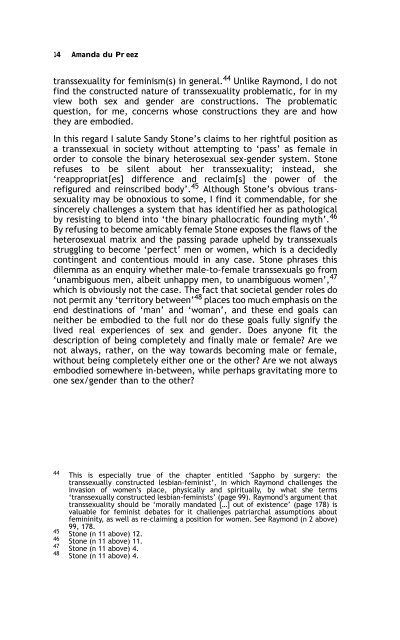Sex, Gender, Becoming - PULP
Sex, Gender, Becoming - PULP
Sex, Gender, Becoming - PULP
You also want an ePaper? Increase the reach of your titles
YUMPU automatically turns print PDFs into web optimized ePapers that Google loves.
14 Amanda du Preez<br />
transsexuality for feminism(s) in general. 44 Unlike Raymond, I do not<br />
find the constructed nature of transsexuality problematic, for in my<br />
view both sex and gender are constructions. The problematic<br />
question, for me, concerns whose constructions they are and how<br />
they are embodied.<br />
In this regard I salute Sandy Stone’s claims to her rightful position as<br />
a transsexual in society without attempting to ‘pass’ as female in<br />
order to console the binary heterosexual sex-gender system. Stone<br />
refuses to be silent about her transsexuality; instead, she<br />
‘reappropriat[es] difference and reclaim[s] the power of the<br />
refigured and reinscribed body’. 45 Although Stone’s obvious transsexuality<br />
may be obnoxious to some, I find it commendable, for she<br />
sincerely challenges a system that has identified her as pathological<br />
by resisting to blend into ‘the binary phallocratic founding myth’. 46<br />
By refusing to become amicably female Stone exposes the flaws of the<br />
heterosexual matrix and the passing parade upheld by transsexuals<br />
struggling to become ‘perfect’ men or women, which is a decidedly<br />
contingent and contentious mould in any case. Stone phrases this<br />
dilemma as an enquiry whether male-to-female transsexuals go from<br />
‘unambiguous men, albeit unhappy men, to unambiguous women’, 47<br />
which is obviously not the case. The fact that societal gender roles do<br />
not permit any ‘territory between’ 48 places too much emphasis on the<br />
end destinations of ‘man’ and ‘woman’, and these end goals can<br />
neither be embodied to the full nor do these goals fully signify the<br />
lived real experiences of sex and gender. Does anyone fit the<br />
description of being completely and finally male or female? Are we<br />
not always, rather, on the way towards becoming male or female,<br />
without being completely either one or the other? Are we not always<br />
embodied somewhere in-between, while perhaps gravitating more to<br />
one sex/gender than to the other?<br />
44 This is especially true of the chapter entitled ‘Sappho by surgery: the<br />
transsexually constructed lesbian-feminist’, in which Raymond challenges the<br />
invasion of women’s place, physically and spiritually, by what she terms<br />
‘transsexually constructed lesbian-feminists’ (page 99). Raymond’s argument that<br />
transsexuality should be ‘morally mandated […] out of existence’ (page 178) is<br />
valuable for feminist debates for it challenges patriarchal assumptions about<br />
femininity, as well as re-claiming a position for women. See Raymond (n 2 above)<br />
99, 178.<br />
45 Stone (n 11 above) 12.<br />
46 Stone (n 11 above) 11.<br />
47<br />
Stone (n 11 above) 4.<br />
48 Stone (n 11 above) 4.
















